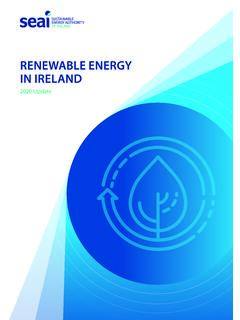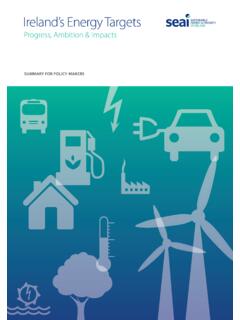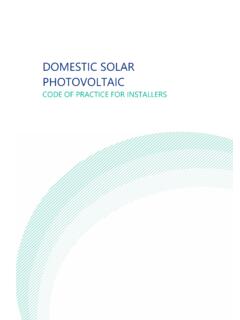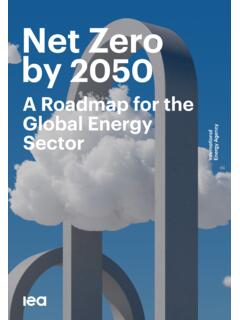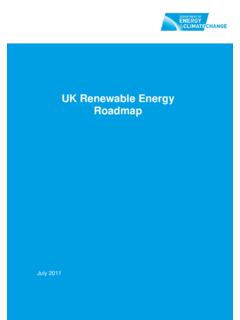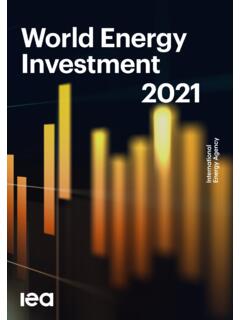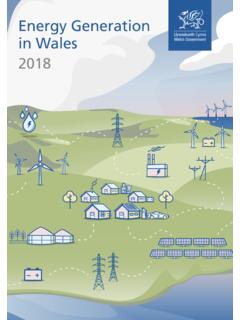Transcription of Energy in Ireland 2020 Report - SEAI
1 Energy IN Ireland 2020 ReportENERGY IN IRELAND2020 Report1 Energy IN Ireland 2020 ReportDecember 2020 Energy IN IRELAND2020 Report2 Sustainable Energy Authority of Ireland (SEAI)SEAI is Ireland s national Energy authority, investing in and delivering appropriate, effective and sustainable solutions to help Ireland s transition to a clean Energy future. We work with Government, homeowners, businesses and communities to achieve this, through expertise, funding, educational programmes, policy advice, research and the development of new technologies. SEAI is funded by the Government of Ireland through the Department of the Environment, Climate and is the official source of Energy data for Ireland .
2 We develop and maintain comprehensive national and sectoral statistics for Energy production, transformation and end-use. These data are a vital input in meeting international reporting obligations, for advising policymakers and informing investment decisions. SEAI s core statistics functions are to: Collect, process and publish Energy statistics to support policy analysis and development in line with national needs and international obligations; Conduct statistical and economic analyses of Energy services sectors and sustainable Energy options; Contribute to the development and promulgation of appropriate sustainability gratefully acknowledges the cooperation of all the organisations, agencies, Energy suppliers and distributors that provided data and responded to questionnaires throughout the year.
3 Sustainable Energy Authority of Ireland , 2020 Reproduction of the contents is permissible, provided the source is IN IRELAND2020 Report3 Foreword2020 has been a year of significant change and challenge for many of us. Due to the global health crisis and measures deployed to mitigate its effects, the way we use Energy has also changed markedly. We have seen large reductions in transport Energy use in particular, and after an initial decrease in electricity use, we saw all time high levels of demand following the recent easing of restriction leading into Christmas 2020. The highlights from this Report illustrate continued success in decarbonisation of electricity, primarily through the reduction of coal and peat use for electricity generation, and from the addition of further installed capacity of wind.
4 This is to be welcomed and significant momentum exists from all stakeholders to continue to drive Ireland forward as a world leader in incorporating renewable Energy on to our electricity system. A bigger story however can be found in sectors where the data did not change significantly in 2019. Energy use for heat in homes and businesses decreased by a mere in 2019 when the impact of a warmer year is taken into account. Collectively these sectors account for over one third of our national Energy use and CO2 emissions from fossil fuel use. The slow level of progress is not yet near the rate required to live up to the Government s ambition in the Climate Action Plan, or the more recent and ambitious Programme for Government.
5 The data in this Report supports the urgent delivery of actions outlined in those plans. As Ireland s National Retrofit Delivery Body, SEAI is closely collaborating with Government and a broad range of stakeholders to support households and businesses to get the necessary work done. This work will accelerate in 2021 with thanks to increased budgets recently committed by Government, together with new suites of programmes and increased human resources dedicated to the task. SEAI is further supporting the Department of Environment, Climate and Communications to analyse pathways to fully decarbonise Ireland s heat use by 2050 a very significant challenge, but one that can be met if given sufficient national priority.
6 The work required to upgrade our homes and business is good for the economy. It creates jobs, enables householders to save on Energy costs now and in the future, and it makes business more efficient leading to competitiveness gains. The environmental benefits are clear. When we burn less fossil fuels, Ireland contributes to global emissions reductions, and at home we experience better air quality, benefitting us all. Deploying Energy efficiency to reduce fossil fuel use and generating more Energy from our vast national renewable sources will also improve our security of Energy supply. At SEAI we have continued to develop our Energy statistics to provide an analytical foundation for policy makers for the many decisions and actions required to decarbonise our Energy system.
7 I would like to take this opportunity to recognise Martin Howley s significant contribution to this process over the last 19 editions of this Report . Martin was instrumental in the establishment and development of an Irish Energy statistical system which is now world class. The foundations laid by Martin will provide the platform for the next wave of data and insights from SEAI. At SEAI we remain focussed on delivering insights and taking actions that will support the transformation of Ireland s Energy system at world leading rates of change. Something we see as entirely possible, as together we make decarbonisation and climate action a national priority. William WalshChief Executive Sustainable Energy Authority of IrelandWilliam WalshENERGY IN IRELAND2020 Report42020 ReflectionsEnergy in Ireland is now in its 19th edition and it feels a bit like the current how it started, how it s going' meme doing the rounds.
8 It started in 2002 when SEAI took over the production and reporting of Energy statistics, which was also around the same time that Ireland ratified the Kyoto Protocol. The first edition covered the period 1990 to 2001 and was designed to provide information on Energy supply and use in Ireland and how it contributed to our new commitments under the Protocol. We are now living through the final year of the second commitment period of the Kyoto Protocol and have since signed up to the landmark Paris Agreement. The current edition of Energy in Ireland reports on Energy use up to 2019 and interestingly, overall Energy use in Ireland in 2019 was at almost the same level as in 2001, but CO2 emissions from Energy are down by almost one fifth, while the economy is one and a half times as large.
9 Over the years since the first edition, SEAI has worked to increase the range and depth of Energy statistics to meet increased demands for data both nationally and internationally. This data is used to monitor progress, develop policy, and to inform and educate us all, as a society, on the role we play in transitioning to a sustainable future. We are most grateful for the cooperation of all those that we request data from and for the help and guidance of the CSO in progressing the development of Energy statistics in Ireland . This year we ve added to the range and depth of Energy statistics by incorporating the Business Energy Use survey results from the CSO into the Energy balance and historic Energy timeseries.
10 This adds more detail to the subsectors of industry and provides a new breakdown of the services sector into a range of subsectors. We ve also added some new Energy sources and expanded the detail on others. One of the big stories of 2019 is the further reduction in CO2 emissions intensity of electricity. Back in 2001, wind supplied approximately 1% of our electricity and coal 20%. The emissions intensity was 807 gCO2/kWh back then but in 2019, with coal generating less than 2% and wind 32%, the intensity is less than half at 324 gCO2/kWh. This was difficult to imagine back then but now the target of 40% of electricity from renewables sources is within sight by the end of this year.
